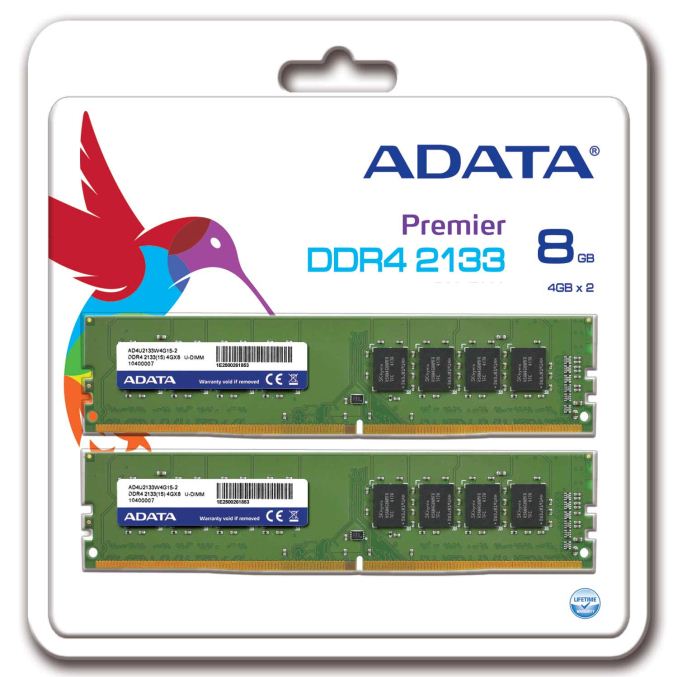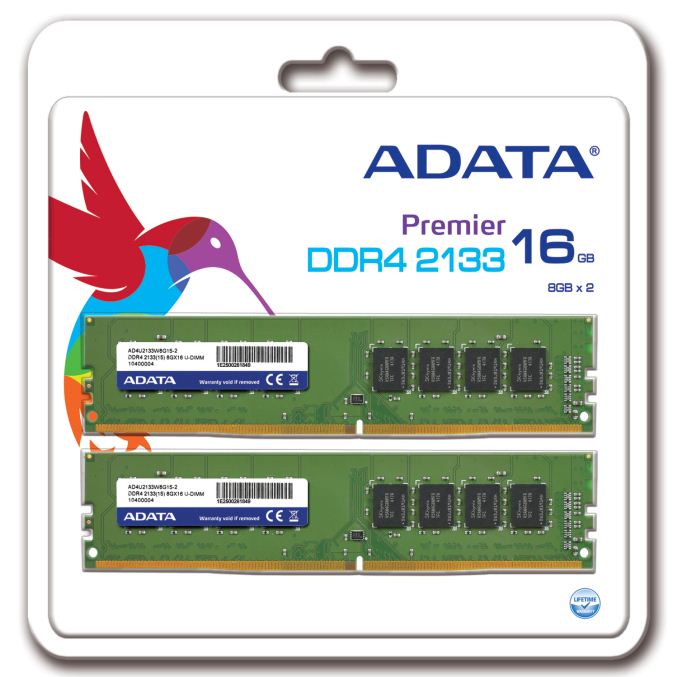ADATA Formally Announces DDR4-2133 CL15 UDIMMs
by Ian Cutress on July 31, 2014 5:17 PM EST
One of the hot topics in computer upgrades for the next couple of years is going to be the move to DDR4. Intel has already announced that the Haswell-E / X99 platform will be based on DDR4, and we can only assume that other future platforms will use it as well. The shift from DDR3 to DDR4 is a the big jump for DRAM manufacturers as well, shifting gears to the new product and maintaining stocks of both for the meantime. ADATA is one of the first to officially launch their consumer memory, their Premier line of DDR4.
JEDEC specifications have the DDR4 base frequency at 2133 MHz with sub-timing latencies of 15-15-15 at 1.2 volts. This is where ADATA will be positioning their first DDR4 modules in the market, and we can assume that others will as well until higher frequency parts are binned. Compare this to the rate of DDR3-2133, which is often at 10-12-12 timings or similar, but uses 1.65 volts, and typically comes with heatsinks.
Because we are far from the launch of a consumer platform for DDR4, as one might expect this comes across more as a paper launch. ADATA in the past typically publishes a PR about new memory about two weeks before it goes on the market, and I am asking about pricing which was not mentioned. Given the pictures we received with the modules, it would seem that 4GB and 8GB modules will be first to market for DDR4 unless another DRAM manufacturer has something up its sleeve.
Source: ADATA














28 Comments
View All Comments
abrowne1993 - Thursday, July 31, 2014 - link
With equal clockspeeds and lower timings, wouldn't the DDR3 example above outperform these DDR4 modules? What's the point in upgrading for a desktop user?drothgery - Thursday, July 31, 2014 - link
DDR4 won't be available for a standard desktop platform for a while. Haswell-E is a server/workstation part.bmayer0122 - Thursday, July 31, 2014 - link
As there is a drop in voltage (1.65 to 1.2v) I would expect the power usage to go down on a per unit of memory basis. Is there any word on that?Thank you
willis936 - Thursday, July 31, 2014 - link
A rule of thumb in processor power consumption is that the max load power is proportional to the clock frequency times the square of the voltage. I promise you that these sticks use much less power than their ddr3 equivalent. That being said they're pretty low performance and in a HEDT environment the tiny amount of power that ddr3 isn't an issue. It matters more in server blades with hundreds of sticks or in laptops were every mW counts.celestialgrave - Friday, August 1, 2014 - link
Is it just me or does there seem to be a lot of wasted PCB space? Would it really cost that much more for them to just make the PCB shorter? Would be nice for those big tower heatsinksDanNeely - Friday, August 1, 2014 - link
I think the vertical heights for the PCB are set in the DDR4 spec itself; even if they don't need the space internally for routing connections in the PCB the height may have been selected for mechanical reasons. If they kept the length the same and but made them shorter they'd become more prone to bending or breaking.Notmyusualid - Friday, August 1, 2014 - link
CL15....Ugly.
StrangerGuy - Sunday, August 3, 2014 - link
The reason why DDR4 still hasn't went mainstream by now is because demand for NAND and LPDDRx is going up while demand for PC DRAM is slowing down.BTW I predict DDR4 will be the very last consumer DRAM to come in DIMMs.